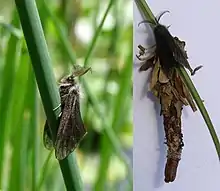Canephora
Canephora is a genus of flowering plants in the family Rubiaceae, indigenous to Madagascar.[1][2]
| Canephora | |
|---|---|
 | |
| Scientific classification | |
| Kingdom: | Plantae |
| Clade: | Tracheophytes |
| Clade: | Angiosperms |
| Clade: | Eudicots |
| Clade: | Asterids |
| Order: | Gentianales |
| Family: | Rubiaceae |
| Subfamily: | Ixoroideae |
| Tribe: | Octotropideae |
| Genus: | Canephora Juss. |
| Type species | |
| Canephora madagascariensis | |
Description
The name Canephora, "basket bearer", refers to both the flattened peduncle topped by a "hollowed apex bearing flowers" and to the ritual office for unmarried young women in ancient Greece, as bearer of a sacred basket full of offerings during processions at festivals.[3]
Canephora is unique in Rubiaceae in having peduncles transformed into flattened, green axes called phylloclades.[4]
Canephora madagascariensis has bright white, campanulate flowers and apparently edible, red fruits, locally known as "hazongalala".[5]
Species
Currently, five species are recognized, but several new species await description.[4]
References
- Jussieu, Antoine Laurent de (August 8, 1789). "Antonii Laurentii de Jussieu Genera plantarum :secundum ordines naturales disposita, juxta methodum in Horto regio parisiensi exaratam, anno M.DCC.LXXIV". apud viduam Herissant et Theophilum Barrois.
- "Canephora in the World Checklist of Rubiaceae". Retrieved June 2014. Check date values in:
|accessdate=(help) - Roccos JL (1995). "The kanephoros and her festival mantle in Greek art". American Journal of Archaeology. 99 (4): 641–666. doi:10.2307/506187. JSTOR 506187.
- De Block P, Vrijdaghs A (2013). "Development of reproductive organs in Canephora madagascariensis (Octotropideae - Rubiaceae)". Plant Ecology and Evolution. 146 (3): 310–327. doi:10.5091/plecevo.2013.844.
- Seligson D (1972). "On collecting herbs in Madagascar". Arnoldia. 32: 23–29.
This article is issued from Wikipedia. The text is licensed under Creative Commons - Attribution - Sharealike. Additional terms may apply for the media files.